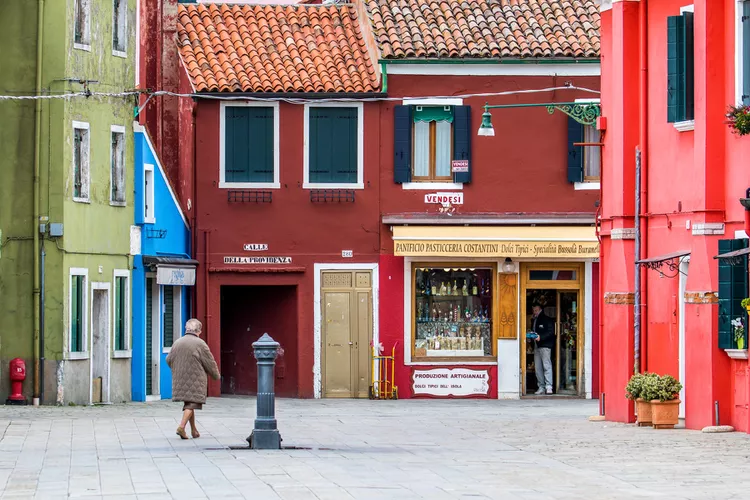This quiet, uncrowded slice of Italy lies just an hour away from Venice.

On a cruise around the northern reaches of the Venetian Lagoon, the only traffic we encounter is a family of swans. We haul up a basket of wriggling soft-shelled crabs, their tiny claws raised defensively as we examine them before lowering them back into the water. Later, I watch, mesmerized, as an old woman tats delicate lace in a pattern as unique and intricate as a fingerprint. At night, I stroll along lamplit canals, still as sheets of glass.
Experience the Contrast Between Venice and Burano
Earlier that day, I walked out of Venice’s Santa Lucia train station to face the Grand Canal, buzzing with vaporetti, delivery boats, gondolas filled with photo-snapping families, and the distinctive clack-clack-clack of rolling suitcases being dragged over marble bridges and sidewalks. The fact that these two worlds — the iconic chaos of Venice and the slow cadence of the northern lagoon — are just an hour from one another seems delightfully absurd.
Discover the Islands of Burano, Mazzorbo, and Torcello
Like Venice, the tiny islands of Burano, Mazzorbo, and Torcello depend — in part, at least — on tourism to stay afloat. However, their residents are determined to keep a lid on it — both to avoid the rampant overtourism that afflicts Venice and to preserve the native traditions that have endured here for centuries. Here, the rhythms of life beat not to the cruise ship schedule, but according to the weather, the tides, and the season.

Visitors arriving in Burano during high season will certainly encounter plenty of their peers. It’s a popular day trip from Venice, often combined with a stop in Murano, the glassblowing island where many studios attract tourists with offers of free tours.
Explore the Unique Charm of Burano
While there’s no hard sell in Burano, there are plenty of touristy shops selling lace, lace, and more lace — much of it of dubious provenance — as well as trattorias tempting the hungry with “tourist menus.” Therefore, it’s easy to spend a few hours in Burano, buying cheap, foreign-made lace, photographing the island’s famously colorful houses, eating a mediocre lunch, and then catching the vaporetto back to Venice. However, Burano, its neighboring islands, and the northern lagoon warrant more time to reveal their nuances.
Plan an Extended Stay for a Deeper Experience
Plan to spend a night or two on Burano, either at one of many Airbnbs on the island or at Casa Burano, an albergo diffuso — a hotel comprised of stylish apartments set across several of those brightly colored houses. Make sure an early morning stroll along the canals is part of your experience. As old women sweep their stoops, fishermen haul in the night’s catch and tend to their boats, the island begins to come to life.
Engage with Local Traditions and Nature
To discover even more about the lagoon and its inhabitants, consider a tour with Domenico and Enrico from Pesca Turismo Nettuno and explore the quiet waterways in a traditional bragozzo (wooden fishing boat). Both gentlemen hail from a long line of fishermen and are committed to protecting the lagoon, sharing their knowledge and passion with visitors, and practicing sustainable fishing and shellfish harvesting techniques that have thrived here for centuries.

Catch the number 9 vaporetto to Torcello and explore the now nearly deserted island where Venice was born when mainland Romans fled Attila the Hun and his landlubber hordes to settle in the safety of the lagoon. That was in 452 CE, and for centuries afterward, Torcello served as a powerful religious center and East-West trade link — more important than Venice, which didn’t surpass it in prominence until the 14th century. The earliest mosaics in the Veneto — dating back to the 11th century — can be found in Torcello’s Basilica di Santa Maria Assunta. Climb the basilica’s bell tower for views of Burano and the marshy, uninhabited islands of the lagoon. Moreover, on a wide bend in the canal, stop at Locanda Cipriani, a satellite of Venice’s famous Harry’s Bar, and enjoy a coffee or cocktail before taking the vaporetto back to Burano.
Once back in Burano, cross the footbridge to Mazzorbo, and wander through the walled garden and vineyard, rife with fruit trees, vegetable plots, and rows of golden Dorona grapevines. The ancient grape, once thought to be extinct, was rediscovered on Torcello by vintner Gianluca Bisol, who revived its cultivation on Mazzorbo. Today, it’s made into spicy, mineral-rich Venissa wines of the namesake Venissa Wine Resort, which offers a Michelin-starred restaurant, an osteria, and overnight lodgings (reservations are advised for all three).

On Burano, shop for meticulously made lace — the real stuff — or simply watch lacemakers at work at Emilia Burano or Martina Vidal. You can also take home brightly colored glass candy after watching it being made at Artistico Bombon. Stop in for only-in-Burano sweets at Pasticceria Costantini and have a meal at the justly famous Trattoria al Gatto Nero, a cozy family-run restaurant where everyone feels like a friend and the risotto di gò alla Buranella made from a small lagoon fish is reputedly the best on the island. Complete your evening on Burano with another passeggiata along its fondamenta (canalside sidewalk).
The canals, still now after the day’s traffic, reflect boats, buildings, and streetlights in mirror-like perfection. The water-lined streets are mostly quiet, except for the occasional group of kids playing past their bedtime or a clutch of old-timers engaging in a raucous card game. This isn’t a cloying Italy staged for tourists; it’s a slice of real-life Italy, in a part of the country that’s unlike any other, with scenes largely unchanged for centuries.





